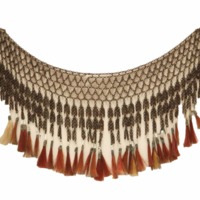Armour ( “Kurab-a-Kulang” )
Text
Share this
Media
Images
Map National Anthropology Museum Madrid
Metadata
Date
1600/1800
Identifier
CE1639
Origin
Maranao (Province of Lanao del Sur, the Philippines)
Materials
Carabao horn, brass, silver
Physical Dimensions
w69 x h79 cm
Provenance
Brought over for an exhibition on the Philippines, Mariana Islands, and Caroline Islands in Madrid in 1887.
Acquisition Date
1887
Short description
Armor made using layered sheets of carabao horn joined with a brass mesh fabric. It is closed at the front using embossed silver clasps.
One type of object used by the Moors in the south of the islands had a clear Spanish origin: their armor. This sort of defensive armor was used exclusively by this community and could not be found in the rest of the Philippines. Native craftsmen copied this armor, which had been taken from the Spanish, making them with native materials they had to hand, such as carabao horn (from the water buffalo). The embossed silver embellishments were shaped into curvilinear motifs characteristic of the "ukkil": scrolls, leaves, vines, etc., though the use of chain links had already been known to the islanders since the 10th century.
One type of object used by the Moors in the south of the islands had a clear Spanish origin: their armor. This sort of defensive armor was used exclusively by this community and could not be found in the rest of the Philippines. Native craftsmen copied this armor, which had been taken from the Spanish, making them with native materials they had to hand, such as carabao horn (from the water buffalo). The embossed silver embellishments were shaped into curvilinear motifs characteristic of the "ukkil": scrolls, leaves, vines, etc., though the use of chain links had already been known to the islanders since the 10th century.
Display status
On Display
Collection
Cite this Page
“Armour ( “Kurab-a-Kulang” ),” Mapping Philippine Material Culture, accessed April 20, 2024, https://philippinestudies.uk/mapping/items/show/2537.
Geolocation
Sensitive Content
Mapping Philippine Material Culture collates digital material from institutions, and some of this material is inherently colonial and contains words, terms and phrases that are inaccurate, derogatory and harmful towards Filipino and Filipino diasporic communities. Catalogue transcriptions, book titles, exhibition titles and museum titles may contain harmful terms. We recognise the potential for the material to cause physical and mental distress as well as evoke strong emotions. Owing to the scale of the collection’s data, a process to implement sensitive-content warnings in the displayed data is still incomplete. The material within the catalogue does not represent Mapping Philippine Material Culture’s views. Mapping Philippine Material Culture maintains a strong anti-colonial, anti-racist position and affirms its support for centring the humanity of historically marginalised and disenfranchised communities.
Facebook Twitter



